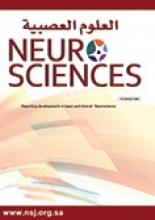Abstract
OBJECTIVE: The objective of this study was to investigate the effect of the cervical traction modality with and without electromyographic (EMG) biofeedback for neck muscles in patients with cervical radiculopathy.
METHODS: This study was carried out at the Department of Rehabilitation Sciences, College of Applied Medical Sciences, King Saud University, Riyadh, Kingdom of Saudi Arabia between February and May 2002. Twenty patients with cervical radiculopathy were randomly divided into 2 equal groups. Group A was treated by a conventional traction modality and group B was treated by a conventional traction modality with EMG biofeedback (to obtain relaxation of paraspinal neck muscles). The average EMG activity was recorded pre and post treatment at cervical (C) 5-6 level for both groups during pull, rest and post traction for a period of 6 weeks.
RESULTS: Comparison of the average EMG activity of the paraspinal C5-6 muscle in different phases of cervical traction showed significant decrease of EMG activity during the pull phases of traction as well as after traction, especially with group B which was treated by the EMG biofeedback modality.
CONCLUSION: Electromyographic biofeedback with cervical traction showed a significant effect in avoiding muscle spasm and decreasing root compression during traction.
- Copyright: © Neurosciences
Neurosciences is an Open Access journal and articles published are distributed under the terms of the Creative Commons Attribution-NonCommercial License (CC BY-NC). Readers may copy, distribute, and display the work for non-commercial purposes with the proper citation of the original work.






